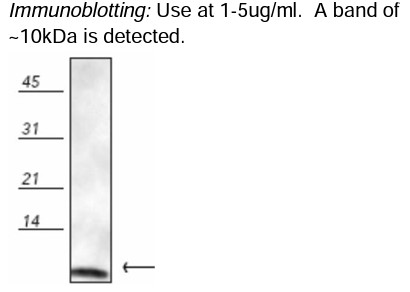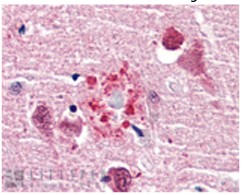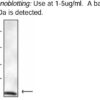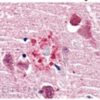Anti-Ubiquitin Antibody (56354-50)
$344.00
SKU: 56354-50
Categories: Antibody Products, Apoptosis Antibodies, Products
Overview
Product Name Anti-Ubiquitin Antibody (56354-50)
Description Anti-Ubiquitin Rabbit Polyclonal Antibody
Target Ubiquitin
Species Reactivity Human, Mouse, Rat, Rabbit, Guinea Pig, Hamster, Sheep, Chicken, Monkey, Bovine, Canine, Porcine, Fish, Yeast, E. Coli, Drosophila, Xenopus
Applications WB,IP,IHC
Host Rabbit
Clonality Polyclonal
Immunogen Native bovine ubiquitin conjugated to KLH.
Properties
Form Liquid
Concentration Lot Specific
Formulation PBS, pH 7.2, 50% glycerol, 0.09% sodium azide.
Buffer Formulation Phosphate Buffered Saline
Buffer pH pH 7.2
Buffer Anti-Microbial 0.09% Sodium Azide
Buffer Cryopreservative 50% Glycerol
Format Purified
Purification Purified by protein A affinity chromatography
Specificity Information
Target Name Polyubiquitin-C [Cleaved into: Ubiquitin]
Target ID Ubiquitin
Gene Name UBC
Gene ID 7316
Accession Number NP_066289.3
Research Areas Apoptosis
Background Ubiquitin is a highly-conserved, 76-amino acid polypeptide expressed in all eukaryotic cells. Ubiquitination of proteins facilitates targeting of cytosolic and nuclear proteins for degradation by proteasomes. This essential cellular process involves a multi-enzyme cascade of ubiquitin- activating enzymes (E1s), ubiquitin-conjugating enzymes (E2s or Ubcs), and ubiquitin-protein ligases (E3s). Ubiquitination is also involved in internalization and degradation of plasma membrane proteins such as T cell receptor subunits while still associated with membranes of the endoplasmic reticulum.
Application Images



Description Detection of ubiquitin in mouse brain lysate.

Description Immunohistochemistry: use at 1-10ug/ml. Detection of ubiquitin in human brain cortex, senile plaque.
Handling
Storage This antibody is stable for at least one (1) year at -20°C.
Dilution Instructions Dilute in PBS or medium that is identical to that used in the assay system.
Application Instructions Immunoblotting: Use at 1-5ug/mL. A band of ~10kDa is detected.
Immunohistochemistry: use at 1-10ug/mL.
These are recommended concentrations.
Endusers should determine optimal concentrations for their applications.
Immunohistochemistry: use at 1-10ug/mL.
These are recommended concentrations.
Endusers should determine optimal concentrations for their applications.
References & Data Sheet
References Li, B., Li, M., et al. Aging (Albany NY) . 2019 Dec 26
11(24):12546-12567
Garcia-Jove Navarro, M., Basset, C., et al. PLoS One . 2013 Aug 7
8(8):e71443
Ribeiro, J. R., Lovasco, L. A., et al. Front Oncol . 2014 Mar 11
4:45
Bouwman, R. D., Palser, A., et al.Retrovirology. 2014 Jul 3
11:53
Leonard, A., Paton, A. W., et al. PLoS One . 2014 Oct 30
9(10):e110949
Kang, K. A., Piao, M. J., et al. Oncotarget. 2016 Jun 28
7(26):40594-40620
Cai, T., Sun, D., et al. J Cell Mol Med. 2018 Mar
22(3):1684-1695
López de la Oliva, A. R., Campos-Sandoval, J. A., et al.Sci Rep. 2020 Feb 10
10(1):2259
Lei, W., Duron, D. I., et al.Front Mol Neurosci. 2019 Nov 29
12:294
11(24):12546-12567
Garcia-Jove Navarro, M., Basset, C., et al. PLoS One . 2013 Aug 7
8(8):e71443
Ribeiro, J. R., Lovasco, L. A., et al. Front Oncol . 2014 Mar 11
4:45
Bouwman, R. D., Palser, A., et al.Retrovirology. 2014 Jul 3
11:53
Leonard, A., Paton, A. W., et al. PLoS One . 2014 Oct 30
9(10):e110949
Kang, K. A., Piao, M. J., et al. Oncotarget. 2016 Jun 28
7(26):40594-40620
Cai, T., Sun, D., et al. J Cell Mol Med. 2018 Mar
22(3):1684-1695
López de la Oliva, A. R., Campos-Sandoval, J. A., et al.Sci Rep. 2020 Feb 10
10(1):2259
Lei, W., Duron, D. I., et al.Front Mol Neurosci. 2019 Nov 29
12:294
PMID 31881009
Data Sheet  Download PDF Data Sheet
Download PDF Data Sheet
 Download PDF Data Sheet
Download PDF Data Sheet





